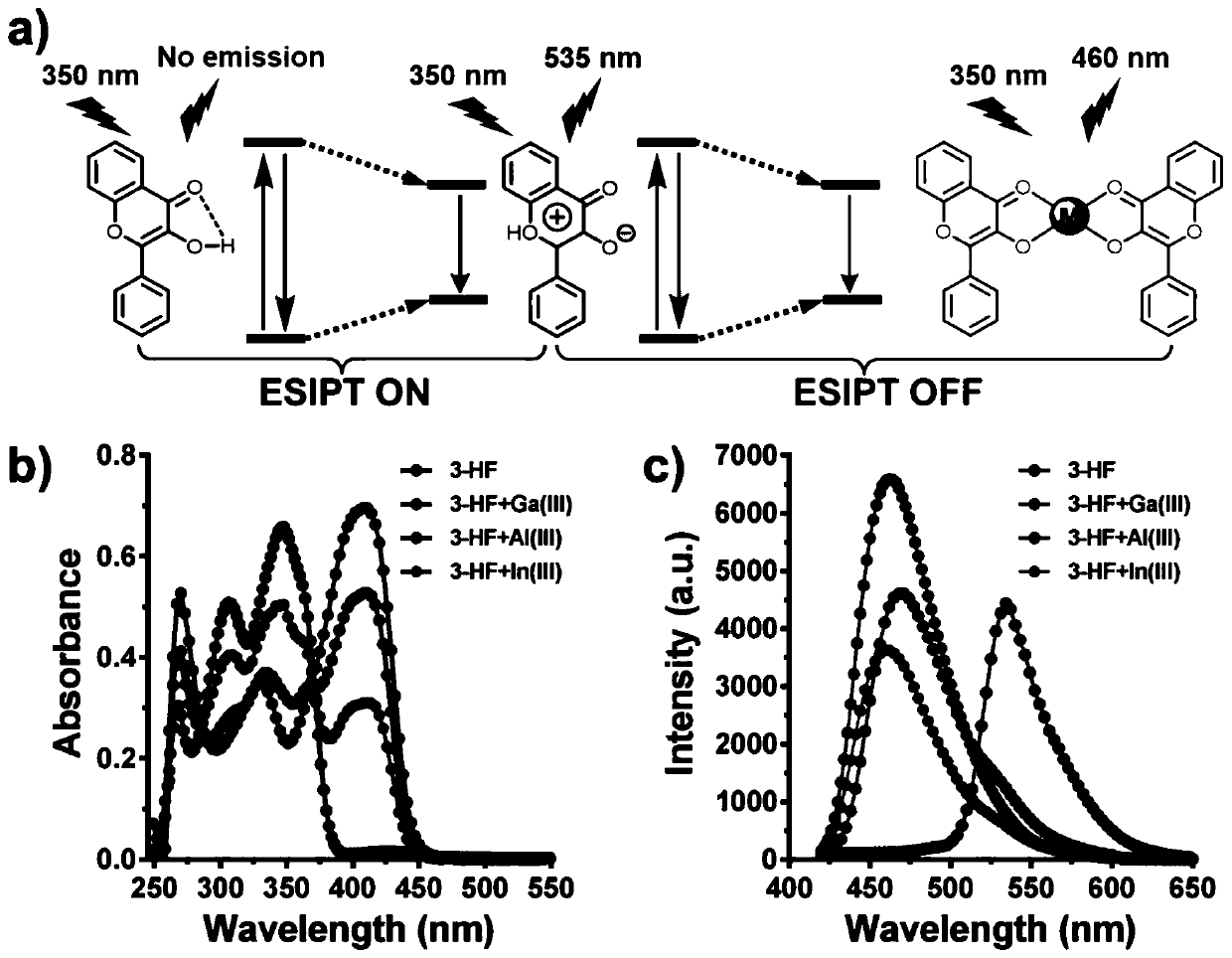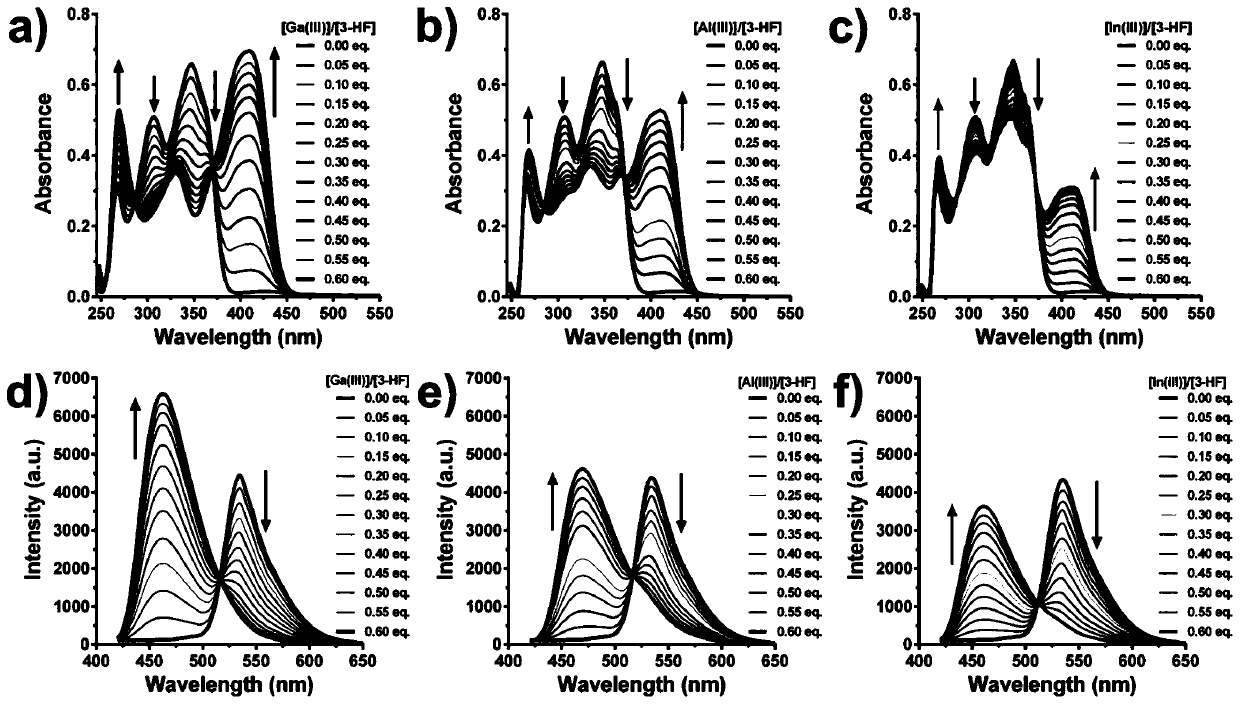Micromolecular fluorescent probe taking 3-hydroxyflavone as fluorophore as well as preparation method and application of micromolecular fluorescent probe
A technology of fluorescent probes and hydroxyflavones, which is applied in the field of fluorescent imaging molecular probes, can solve the problems of simultaneous detection of fluorescent probes, and achieve the effects of simple synthesis methods, good application prospects, and convenient operation
- Summary
- Abstract
- Description
- Claims
- Application Information
AI Technical Summary
Problems solved by technology
Method used
Image
Examples
Embodiment 1
[0024] The spectroscopic properties of 3-hydroxyflavone after recognizing the third main group metal ion in Example 1
[0025] 3-Hydroxyflavone (3-HF), as a sensitive fluorescent probe for group IIIA ions including Ga(III), Al(III) and In(III) ions, has a common The fluorophores of the conjugated system are used for the selective detection of group IIIA ions. figure 1 a and b show the molecular structures of 3-HF and 3-HF-Group IIIA complexes, respectively. The spectroscopic properties of 3-HF exhibit an excited-state intramolecular proton transfer (ESIPT) reaction, accompanied by a clear band separation between the normal and photopolymeric forms in the emission spectrum, which is believed to be indicative of the interaction. 3-HF-solvent and 3-HF-cation in the corresponding complexes. Furthermore, we present a proposed 3-HF sensing mechanism with Ga(III), Al(III) and In(III) ions, as figure 2 as shown in a. The C=O ans-OH group of 3-HF plays an important role in the coo...
Embodiment 2
[0026] 3-hydroxyflavone recognition metal ion spectrometric titration in embodiment 2
[0027] The concentration dependence of the 3-HF response to group IIIA ions was studied. UV-Vis spectra of 3-HF in different amounts of Ga(III), Al(III) and In(III) ions ( image 3a, 3b, 3c). After adding the concentration of metal ions, the dark yellow solution system was obtained from light yellow, and the absorption peaks of 3-HF around 307nm and 347nm gradually decreased, and the specific absorption peak at 409nm was formed with a red shift (62nm). And, to examine the symbolic 3-HF fluorescence response to Ga(III), Al(III) and In(III) ions, as image 3 d, 3e, 3f, free 3-HF shows sign fluorescence at 535. When excited at 350 nm, the emission spectrum of 3-HF shows a large blue shift at 75 nm (from 535 nm to 460 nm), with an iso-emission point at 516 nm. With DMSO-H 2 The ratio of emission intensity (I460nm / I535nm) increases sharply with the increase of metal ion concentration in O(5...
Embodiment 3
[0028] Example 3 verifies the selectivity and competitiveness of small molecule probes to Ga(III), Al(III) and In(III).
[0029] Prepare 5.0mL molecular probe (5.0×10 -6 mol / L) of DMSO / H 2 O (v / v=1:1) solution. Various metal cation solutions [K(I), V(IV), Fe(III), Ca(II), Dy(III), Er(III), Al(III) were prepared by dissolving the corresponding salts in deionized water ), Cr(III), Ga(III), Bi(III), Ni(II), Zn(II), Co(II), In(III), Mn(II) and Cu(II)] (1.0× 10 -3 mol / L). Subsequently, an equivalent equivalent of the metal cation solution was added to the probe solution. Detection is carried out by fluorescence spectroscopy, the experimental results are shown in Figure 8 (a). Take the fluorescence maximum absorption wavelength for comparison, such as Figure 8 As shown in (b, c), ions include K(I), V(IV), Fe(III), Ca(II), Dy(III), Er(III), Al(III), Cr(III), Ga(III), Bi(III), Ni(II), Zn(II), Co(II), In(III), Mn(II) and Cu(II). Except for Ga(III), Al(III) and In(III) ions,...
PUM
 Login to View More
Login to View More Abstract
Description
Claims
Application Information
 Login to View More
Login to View More - R&D
- Intellectual Property
- Life Sciences
- Materials
- Tech Scout
- Unparalleled Data Quality
- Higher Quality Content
- 60% Fewer Hallucinations
Browse by: Latest US Patents, China's latest patents, Technical Efficacy Thesaurus, Application Domain, Technology Topic, Popular Technical Reports.
© 2025 PatSnap. All rights reserved.Legal|Privacy policy|Modern Slavery Act Transparency Statement|Sitemap|About US| Contact US: help@patsnap.com



